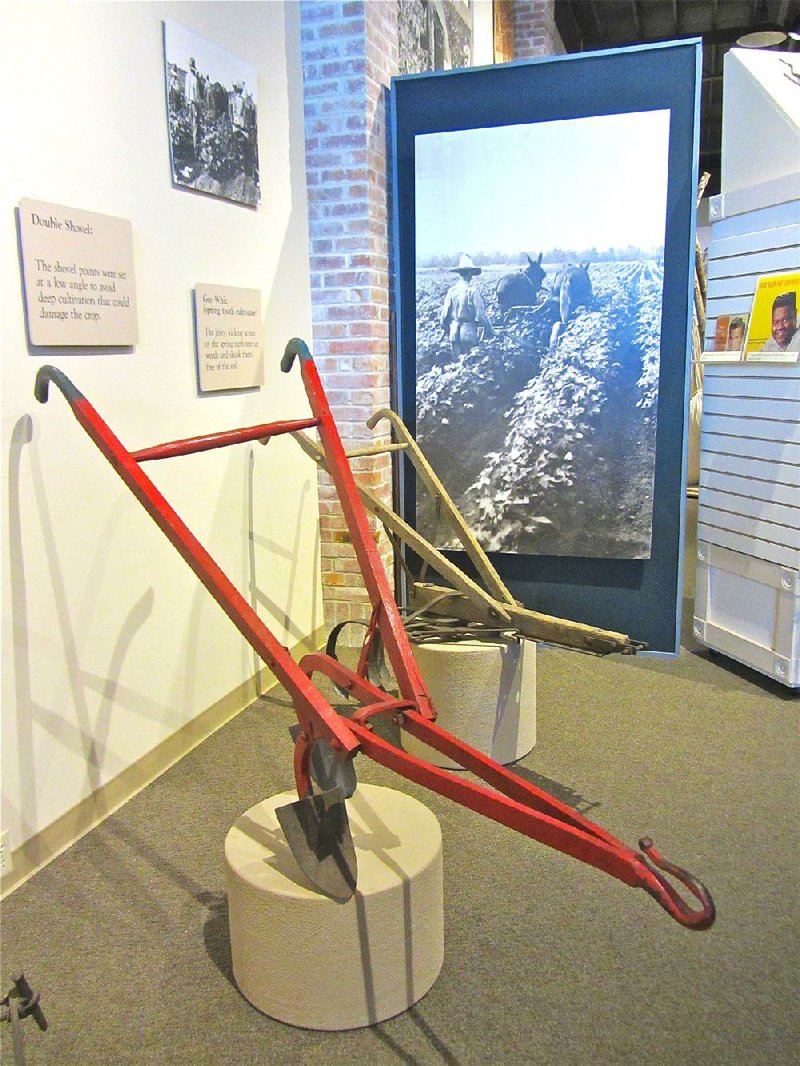SCOTT - In case you wondered, a bale of cotton is enough to make 313,600 dollar bills.
That’s among the wealth of facts and insights greeting visitors at the Plantation Agriculture Museum, a unit of the Arkansas Department of Parks and Tourism located in Scott, 14 miles east of downtown Little Rock.
U.S. currency contains 75 percent cotton (the rest being linen), and a 500-pound bale goes a long way in cranking out the do-re-mi. It could also produce 8,347 handkerchiefs, 1,217 T-shirts or 215 pairs of jeans.
Located in a century-old general store, the museum does a sprightly job of detailing what life was like on the state’s cotton plantations from Arkansas’ admission to the Union in 1836 through the rapid farm mechanization around World War II.
Exhibits delve into less salubrious aspects of the plantation system, which operated mainly with slave labor through the Civil War. A sign reports that the 1860 U.S.
census counted 111,115 slaves in Arkansas, nearly one-quarter of the state’s population.
Sharecropping largely replaced slavery after the Civil War. But working conditions remained rigorous during the annual cycle of plowing,planting, cultivating and picking.
Especially onerous was the picking, a back-breaking hand labor since supplanted by machines. Pickers were said to describe their work hours as “from can to can’t” - from when they could first see the sun at dawn to when they couldn’t any longer at sunset. The picking was so labor-intensive that many rural schools would close for the occasion.
Among the museum’s revelations to city slickers will be the vital role that mules played in the plantation economy. It was said that these sturdy crosses of a male donkey and a female horse were “as necessary as the sun and rain.” A large plantation might keep as many as 500 mules for pulling plows and other field work.
A reminder that the so called “good old days” would wear most of us to a frazzle today is a mock-up of a kitchen from more than 100 years ago. It features a wood-burning cook stove, an icebox that required regular visits from the iceman, a pitcher pump, a wringer washing machine and other relics of the time before rural electrification.
Another exhibit portrays the remarkable life of Scott Winfield Bond, who was born a slave in 1852 and freed at age 13 when the Civil War ended. Through cotton farming, orchards and other enterprises, Bond was one of the state’s wealthiest black residents when he died in 1933.
Current exhibits also explain dairy and poultry farming in the decades before World War II. Visitors unversed in the raising of chickens may be nonplussed by an object in one glass case. It’s a 5-ounce can of Bee Dee Laxative for Poultry, priced at 25 cents. Who would have ever guessed that barnyard fowl might need such assistance?
Outside the museum’s main building, an assortment of vintage steam traction engines and other plantation machinery will tempt photographers. One unusual device is a cotton pen, built on runners and generally pulled by mules, into which freshly picked cotton would be dumped on its way to a gin.
Across the way, the museum’s Dortch Gin Building,dating to 1919, gives a vivid sense of the complex ginning process, with its pair of 80-saw gin stands, a two bale press, blowers and belts. A larger structure from 1948, Seed Warehouse No. 5, is entered through old boxcars from the Cotton Belt Railroad. The Robert L. Dortch family founded the museum, which was reopened in 1986 as a state park.
Nicely complementing the museum’s rustic flavor is ever-popular Cotham’s Mercantile, housed nearby in a ramshackle general store built in 1917. Just an hour or two of picking cotton by hand in bygone times surely would have aroused an appetite large enough to conquer Cotham’s redoubtable Hubcap Burger.
The Plantation Agriculture Museum, at the junction of U.S. 165 and Arkansas 161 in Scott, is open 8 a.m.-5 p.m. Tuesday-Saturday, 1-5 p.m. Sunday. Admission is free; guided tours are available at $4 per adult, $3 per child 6-12, $12 per family including all children 18 and under. For details, call (501) 961-1409 or visit arkansasstateparks.com.
Weekend, Pages 36 on 12/19/2013
